The sumo deadlift high pull is the Rodney Dangerfield of CrossFit movements – it gets no respect. Far be it from me to tell you anything different. Eff the SDHP.
The Muscle Clean: A Better Option Than the SDHP
But I understand why CrossFit Headquarters included the SDHP in the Nine Basic Movements of CrossFit. They needed an exercise progression that would prepare new athletes for the barbell clean. The deadlift teaches a strong setup and straight bar path. The medicine ball clean teaches how to retreat under a load and receive it in a squat.
What was needed was a second stage, a movement that utilized an explosive extension of the hip and a strong arm pull to elevate the load, a movement that could be taught in a seminar setting, with PVC pipe. The SDHP fit the bill.
The sumo deadlift high pull.
But in CrossFit, where the sumo deadlift is a rara avis and the upright row non-existent, the SDHP really has no transference to any other exercise commonly practiced. There’s a better option to teach explode-and-pull, an unjustly overlooked exercise that does not put the shoulder into compromised positions, affords cleaner execution at high intensity, and has direct carryover to the full clean.
The muscle clean. The muscle clean has the same first and second pull as the power and squat clean, but after the extension of the hips, the athlete remains standing tall, pulling the bar chest high before rotating the elbows in a flash from above and behind the bar (at the apex of the pull) to in front of and parallel to the bar (in the rack position). So there’s your hip extension followed by arm pull, same as the SDHP. Only now the motor patterns truly do help the athlete progress towards more complex movements.
The Muscle Clean Is the Best Way to Introduce the Clean
Pedagogically, the muscle clean is simply the best way to introduce the clean. If a trainee hasn’t mastered the front squat, is dropping under the bar to catch it going to end well? (Short answer: no.) Make it easy on your new athlete, and let him concentrate on the mechanics of the first, second, and third pulls before adding complexification.
Concurrently, he’ll be improving his front squats, and eventually can begin receiving the bar lower and lower (the height of the catch being a function of the load relative to his power), in efficient, aesthetically pleasing positions. This may fly in the face of traditional weightlifting pedagogy, but that’s okay. Our goal is not to create weightlifters, but CrossFitters who can clean and snatch competently.
In terms of metcons, the muscle clean is superior to the SDHP both practically and philosophically. As mentioned earlier, at high reps performance of the SDHP breaks down – knees and hips fail to fully straighten and thoracic spines turn kyphoid – because all that matters is that the bar somehow make it up under the chin.
The muscle clean, on the other hand, ends only one way: knees and hips extended, elbows high. There’s no judgment call to make. The fact that the cycle time of the muscle clean is more or less the same as that of the SDHP makes it a better choice for a workout like Fight Gone Bad. At the same prescribed weight (75/55lbs), scores will be nearly identical.
Cycle rate of the muscle clean versus sumo deadlift high pull.
A Good Muscle Clean Beats a Bad Power Clean
Let us make an assertion. It’s always better to have athletes perform a simpler movement well than a more complex movement poorly. Take a workout like this one:
“The Chief”
Five cycles of
- AMRAP 3: 3 power cleans (135/95lbs), 6 push-ups, 9 squats
- Rest one minute
Strong athletes often pull that 135/95lbs from the floor straight up to their shoulders, with perhaps a perfunctory knee rebend before standing to completion. See the video below for an example. No foot slide from pulling to receiving position, no retreat of the hip, no drop. Is that really a power clean?
No, it’s not a power clean. Not that those athletes can’t perform competent power cleans. The problem is a drop and reset would interfere with the goal of maximizing repetitions during the work interval.
But why do a half-assed power clean when you could do a technically sweet muscle clean and achieve your same goal? Ground-to-shoulder-anyhow shouldn’t and doesn’t cut it. If virtuosity is really what we’re chasing in our gyms, then athletes should discipline themselves to perform a simpler movement – the muscle clean – and display mastery.
This is not to say strong athletes shouldn’t start to power clean as they fatigue or that slightly less strong athletes shouldn’t power clean the load from the start. By all means they should. But by God, make them good power cleans. Don’t be a hack. Not if you can help it. Excellence is its own reward.
Teaching the Muscle Clean to a Large Group
Here’s a cool way to teach the muscle clean to a large group. Note: unlike the SDHP, the muscle clean should not be taught with PVC pipe. Few people can front rack PVC, and as the plastic is virtually weightless, it’s hard to get any sense of how forceful hip extension affects the perceived weight. Each athlete should have her/his own light (15lbs and/or 15kg) barbell for drills.
In the By the Numbers (BTN) system, the muscle clean is broken down into seven positions that are taught one at a time and then drilled in small sets. Only once all positions and drills have been mastered are the pieces joined and smoothed into the complete movement. BTN requires athletes to master the muscle clean before learning the power clean, and then mastering the power clean before attempting the full clean.
One caveat: If you have an athlete who was struggling with the front squat rack position due to mobility issues, don’t teach him the barbell clean. You’re just setting him up for injury. Instead teach the clean variations with dumbbells or kettlebells, and assign a whole mess of mobility work to help the athlete develop a decent front rack.
How to Teach the Muscle Clean By the Numbers
Let’s start by reviewing front rack position, because that’s where you’re going to catch the bar at the end of the muscle clean.
Take a clean-width grip on the bar (about thumb’s length from the edge where the gnurling meets the smooth central section of the bar) and curl it up onto your shoulders. Elevate your shoulders and lift your elbows until they are pointing straight ahead. Let your fists relax and the bar to roll back on your fingertips. Ideally, the elbows and wrists should be in line. Remember, the bar should be resting on your shoulders, not in your hands.
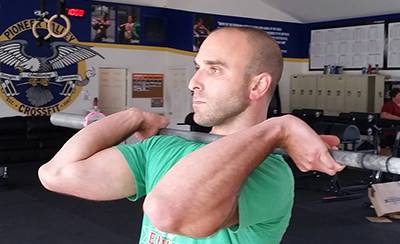
Rack position
Following our principals of best leverage and best efficiency, in the muscle clean the barbell travels in a straight line up the torso before coming to rest on the shoulders. We’re going to rehearse that bar path.
Lower the bar to waist height.
At this point let’s establish what we’ll call “reset” position: feet under the hips (six to eight inches apart), midline braced, shoulders back, arms internally rotated so that the elbows point outward, and wrists curled under. When “reset” is called, return to this position.
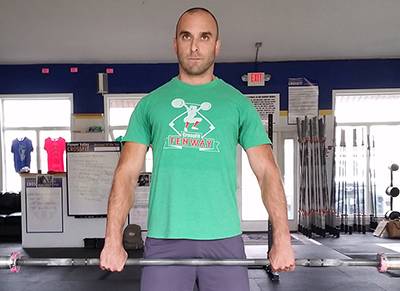
Reset position. Feet hip width, midline braced, shoulders externally rotated, arms internally rotated, wrists flexed.
Shrug your shoulders up and back, elevating the bar but keeping it close to the body. This is Muscle Clean Position 5, also known as “finish.”
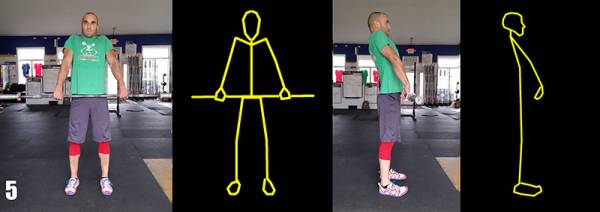 Muscle Clean 5. Weight in heels, knees and hips fully extended, shoulders shrugged up and back, arms straight.
Muscle Clean 5. Weight in heels, knees and hips fully extended, shoulders shrugged up and back, arms straight.
Now lift the bar by pulling your elbows to parallel and slightly behind the shoulders. The bar should remain within an inch of the chest. This is Muscle Clean 6, also known as “scarecrow.”
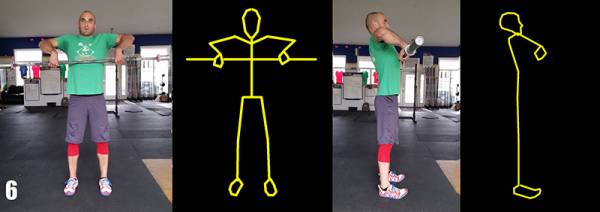 Muscle Clean 6. Elbows high and back, pulling bar to sternum.
Muscle Clean 6. Elbows high and back, pulling bar to sternum.
Finally, spin your elbows around the bar to park it on your shoulders in front rack position. This is Muscle Clean 7, “rack.”
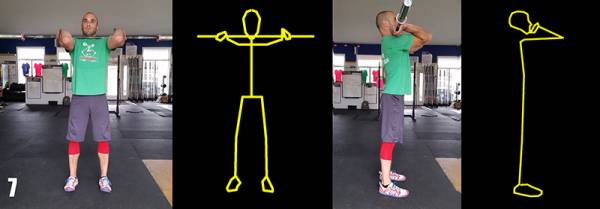 Muscle Clean 7. Full stand, bar racked up on shoulders with elbows high and in front.
Muscle Clean 7. Full stand, bar racked up on shoulders with elbows high and in front.
Muscle Clean positional drill “Reset! Go!”
Reset. Now, squeeze your butt tight, and flare your knees out so that you sit down about two or three inches. Keep your weight back on your heels. This position should be familiar to you. It’s the dip from the push press. Now, though, the bar rests about three-quarters of the way up your thighs, right where the pockets of your jeans would be. This is Muscle Clean 4, or “pockets.”
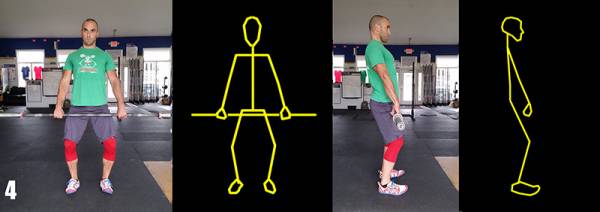 Muscle Clean 4. Weight in heels, knees flared out, sitting down 2-4”, bar brushing leg at pockets height, torso vertical, arms straight, shoulders behind bar.
Muscle Clean 4. Weight in heels, knees flared out, sitting down 2-4”, bar brushing leg at pockets height, torso vertical, arms straight, shoulders behind bar.
Driving through your heels, stand explosively and shrug simultaneously into Muscle Clean 5.
Now 6!
“7! Fast elbows!
Did the bar feel lighter that time? It’s because the powerful extension of your hip put momentum on the bar that effectively makes it lighter, and thus easier to pull up onto your shoulders. This aggressive extension from 4 to 5 is the heart of the clean.
Reset. And here we go again…
4!
Etcetera. Repeat until you feel your athletes are getting the hang of it.
Muscle clean positional drill “4! Go!”
We’re now going to work on pulling from the floor. Understand that each new stage we’ll look at it is only setting you up for that explosion at Position 4.
Ok, reset.
We’ll practice as if we have bumpers on our bar. The bumpers we use have a diameter of eighteen inches. This is standard. An eighteen-inch diameter means the bumpers have a radius of nine inches. Squat down behind the bar until it’s about nine inches off the floor.
Unlike the set-up for the deadlift, when setting up for the clean, allow the bar to travel out from the shin until it’s over the point at which your big toe meets your foot. Usually, about where your laces begin. The weight is evenly distributed across the foot, the knees flared out. Arms straight, shoulders directly over the bar, the spine in “absolute” extension, gaze forward. This is Muscle Clean 1, or “floor.”
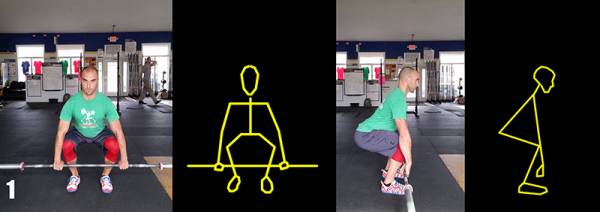 Muscle Clean 1. Feet hip width, weight slightly in front of center of foot, bar out over foot, arms straight, shoulders over bar, back in strong extension, gaze directed forward.
Muscle Clean 1. Feet hip width, weight slightly in front of center of foot, bar out over foot, arms straight, shoulders over bar, back in strong extension, gaze directed forward.
Next: driving with the legs, not with the hips, stand until the bar to just touching the bottom of the knee cap. The back angle should be maintained from Muscle Clean 1, flaring the knees out wide as the bar rises, instead of pulling them back, helps. Be patient! This is Muscle Clean 2, “hang below the knees.”
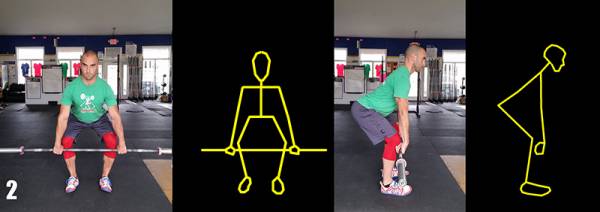 Muscle Clean 2. Bar rises to bottom of knee cap, back angle same as Muscle Clean 1.
Muscle Clean 2. Bar rises to bottom of knee cap, back angle same as Muscle Clean 1.
From 2, push with the legs while simultaneously sweeping the bar back into the body. Your hips will rise, and your shoulders will come out slightly in front of the bar. The bar will rise several more inches up the thigh. This is Muscle Clean 3. 3 puts tension on the hamstring, which is vital for the explosive hip extension to come.
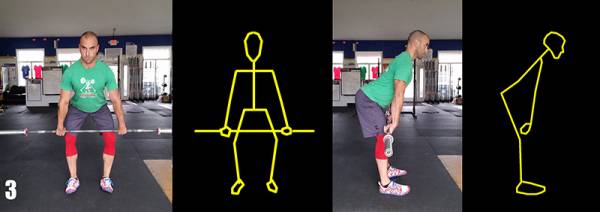 Muscle Clean 3. Shins vertical, bar swept in and 2-3” above knee, shoulders in front of bar.
Muscle Clean 3. Shins vertical, bar swept in and 2-3” above knee, shoulders in front of bar.
As the bar reaches mid-thigh, shift the torso to vertical while simultaneously sitting straight down over the heels. This returns us to Muscle Clean 4.
Now, on my command, execute a muscle clean from the high hang: positions 5, 6, and 7. Go!
 Muscle Clean positions 1-2-3-4-5-6-7
Muscle Clean positions 1-2-3-4-5-6-7
Muscle Clean positional drill “1! 2! 3! 4! Go!”
“4! Go!” becomes “3! Go!” becomes “2! Go!” At “1! Go!” your athletes are executing a smooth muscle clean. An explanation should be made that the shift from 1 to 2 is relatively slow and deliberate, 2 to 3 to 4 is an acceleration, and 4 turns into 5 at maximum velocity.
Reinforcing Good Motor Patterns
When they are in a weightlifting training session or using the muscle clean to get the bar up to their shoulders before doing thrusters in a workout, our new trainees are required to perform the muscle clean in this segmented fashion (“1! 2! 3! 4! GO!”) until they can hit each position accurately with unconscious competence. Only then do we have them start pulling from the floor at speed or using it as a conditioning tool.
Up to that point, we substitute kettlebell swings for muscle cleans. After all, what’s the point of having someone do dozens of muscle cleans if they’re going to be performed badly? That only reinforces poor motor patterns and ultimately retards your athletes’ progress in CrossFit.
It helps to think of WODs as a demonstration of capacity, a type of performance. If you were a musician, would you want to walk onstage and attempt a song you can barely play? Heck no. Far better to perform a song you know you can rock.
Think about it. And stop doing sumo deadlift high pulls. The muscle clean rules!
Photo 1 “CrossFit Kandahar” by Kandahar CrossFit ANZAC Day. Attribution-NonCommercial License.






